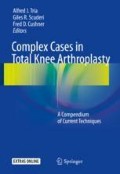Abstract
The primary goal of total knee arthroplasty (TKA) is to create a well-aligned and well-balanced knee. Femoral sizing and component alignment, as well as the balance of the extension and flexion gap, are requirements for a well-functioning TKA. Distal femoral preparation, sizing, and component placement, with attention to proper alignment in the coronal, sagittal and rotational planes, are essential in creating a well-balanced implant. The intent is to create a consistent flexion gap and restoring posterior condylar offset. The etiology of instability is due to failure to balance the flexion and extension gaps, and flexion instability develops when the flexion gap is larger than the extension gap [1].
Access this chapter
Tax calculation will be finalised at checkout
Purchases are for personal use only
References
Clarke HD, Scuderi GR. Flexion instability in primary total knee replacement. J Knee Surg. 2003;16(2):123–8.
Schwab JH, Haidukewych GJ, Hanssen AD, Jacofsky DJ, Pagnano MW. Flexion instability without dislocation after posterior stabilized total knees. Clin Orthop Relat Res. 2005;440:96–100.
Pagnano MW, Hanssen AD, Lewallen DG, Stuart MJ. Flexion instability after primary posterior cruciate retaining total knee arthroplasty. Clin Orthop Relat Res. 1998;(356):39–46.
Deshmane PP, Rathod PA, Deshmukh AJ, Rodriguez JA, Scuderi GR. Symptomatic flexion instability in posterior stabilized primary total knee arthroplasty. Orthopedics. 2014;37(9):768–74.
Parratte S, Pagnano MW. Instability after total knee arthroplasty. J Bone Joint Surg Am. 2008;90(1):184–94.
Vince KG, Abdeen A, Sugimori TJ. The unstable total knee arthroplasty: causes and cures. Arthroplasty. 2006;21(4 Suppl 1):44–9.
Rodriguez-Merchan EC. Instability following total knee arthroplasty. HSS J. 2011;7(3):273–8.
Abdel MP, Haas SB. The unstable knee: wobble and buckle. Bone Joint J. 2014;96-B(11 Suppl A):112–4.
Deshmane PP, Rathod PA, Deshmukh AJ, Rodriguez JA, Scuderi GR. Symptomatic flexion instability in posterior stabilized primary total knee arthroplasty. Orthopedics. 2014;37(9):e768–74.
Romero J, Stähelin T, Binkert C, Pfirrmann C, Hodler J, Kessler O. The clinical consequences of flexion gap asymmetry in total knee arthroplasty. J Arthroplasty. 2007;22(2):235–40.
Engh GA, Koralewicz LM, Pereles TR. Clinical results of modular polyethylene insert exchange with retention of total knee arthroplasty components. J Bone Joint Surg Am. 2000;82(4):516–23.
Brooks DH, Fehring TK, Griffin WL, Mason JB, McCoy TH. Polyethylene exchange only for prosthetic knee instability. Clin Orthop Relat Res. 2002;405:182–8.
Willson SE, Munro ML, Sandwell JC, Ezzet KA, Colwell CW Jr. Isolated tibial polyethylene insert exchange outcomes after total knee arthroplasty. Clin Orthop Relat Res. 2010;468(1):96–101.
Fehring TK, Valadie AL. Knee instability after total knee arthroplasty. Clin Orthop Relat Res. 1994;(299):157–62.
Moreland JR. Mechanisms of failure in total knee arthroplasty. Clin Orthop Relat Res. 1988;(226):49–64.
Warren PJ, Olanlokun TK, Cobb AG, Walker PS, Iverson BF. Laxity and function in knee replacements. A comparative study of three prosthetic designs. Clin Orthop Relat Res. 1994;305:200–8.
McAuley JP, Engh GA, Ammeen DJ. Treatment of the unstable total knee arthroplasty. Instr Course Lect. 2004;53:237–41.
Azzam K, Parvizi J, Kaufman D, Purtill JJ, Sharkey PF, Austin MS. Revision of the unstable total knee arthroplasty: outcome predictors. J Arthroplasty. 2011;26(8):1139–44.
Kannan A, O’Connell RS, Kalore N, Curtin BM, Hull JR, Jiranek WA. Revision TKA for flexion instability improves patient reported outcomes. J Arthroplasty. 2015;30(5):818–21.
Sharkey PF, Hozack WJ, Rothman RH, Shastri S, Jacoby SM. Insall Award paper. Why are total knee arthroplasties failing today? Clin Orthop Relat Res. 2002;(404):7–13.
van Kempen RW, Schimmel JJ, van Hellemondt GG, Vandenneucker H, Wymenga AB. Reason for revision TKA predicts clinical outcome: prospective evaluation of 150 consecutive patients with 2-years followup. Clin Orthop Relat Res. 2013;471(7):2296–302.
Grayson CW, Warth LC, Ziemba-Davis MM, Michael Meneghini R. Functional improvement and expectations are diminished in total knee arthroplasty patients revised for flexion instability compared to aseptic loosening and infection. J Arthroplasty. 2016;31(10):2241–6.
Hofmann AA, Tkach TK, Evanich CJ, Camargo MP. Posterior stabilization in total knee arthroplasty with use of an ultracongruent polyethylene insert. J Arthroplasty. 2000;15(5):576–83.
Kelly MA. Ligament instability in total knee arthroplasty. Instr Course Lect. 2001;50:399–401.
Vince KG. Why knees fail. J Arthroplasty. 2003;18(3 Suppl 1):39–44.
Abdel MP, Pulido L, Severson EP, Hanssen AD. Stepwise surgical correction of instability in flexion after total knee replacement. Bone Joint J. 2014;96-B(12):1644–8.
Author information
Authors and Affiliations
Corresponding authors
Editor information
Editors and Affiliations
Rights and permissions
Copyright information
© 2018 Springer International Publishing AG
About this chapter
Cite this chapter
Scuderi, G.R., Berliner, Z.P., Rodriguez, J.A., Klein, G.R., Kelly, M.A. (2018). Flexion Instability. In: Tria, A., Scuderi, G., Cushner, F. (eds) Complex Cases in Total Knee Arthroplasty. Springer, Cham. https://doi.org/10.1007/978-3-319-69380-4_10
Download citation
DOI: https://doi.org/10.1007/978-3-319-69380-4_10
Published:
Publisher Name: Springer, Cham
Print ISBN: 978-3-319-69379-8
Online ISBN: 978-3-319-69380-4
eBook Packages: MedicineMedicine (R0)

